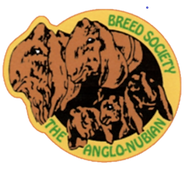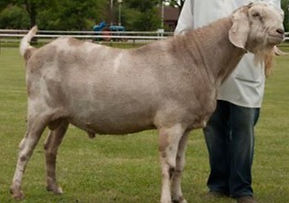
Founded 1972. Affiliated to the British Goat Society.
Appearance of the Breed
The ideal Anglo-Nubian is an alert, sound, well balanced animal. It stands four-square and possesses the capacity and breeding ability of a good milking goat. It has a high, proud head carriage and majestic bearing.
The Anglo-Nubian has long, pendulous ears and the nasal bone is markedly convex in shape. The stance is more upright than the Swiss breeds. There is a pronounced brisket and high withers.
The females have a short glossy coat, and one of its most attractive features is the variety in colour. All coat colours are permissible; chestnut, fawn, black, white or cream. Many colour combinations are found which give some very attractive mottled or marbled animals.
It is a breed which improves with age and there are instances of females breeding and milking well when past twelve years of age.
Many animals of the breed are prolific and renowned for their fecundity. Twins, triplets or quadruplets being common when the dam is well managed.
It is one of the heaviest and tallest breeds of goat, with males weighing up to 140Kgs and females to 110Kgs. The males have a longer and harsher coat than the females. The convexity of a male's head is often highly pronounced (see photo). Males display the same upright stance and variety in colour as the females. They are very sturdy and strong.
Ango-Nubian Breed Standard
GENERAL APPEARANCE - The ideal is an alert, sound, well balanced animal standing foursquare and possessing the capacity and breeding ability of a good milking goat, with a high proud head carriage and majestic bearing.
HEAD - Short, with the base of the cheekbone to the highest part of the head equal to the distance from the nose to the maxillary joint. Pronounced convex nasal bone, head carried high. A wry nose is not acceptable.
EYES - Medium sized, set obliquely and wide apart, almond shaped giving a supercilious expression.
EARS - Long and pendulous, set low on the head, wide and open. Longer than the nose when measured against it.
MOUTH - The teeth should meet the hard pad of the upper jaw, but an undershot jaw would not be penalized provided the teeth were not visible.
NECK - Long and fine, without tassels.
HORNS - If horned, these should be set wide apart and should sweep backwards without any outward curve.
FOREQUARTERS - The withers should be high, shoulders fine, merging smoothly into the body, broad between the points, good heart room. Fore legs straight, squarely set below the animal, slightly longer than the depth through the girth. Pasterns, short and upright.
BODY - Long, the croup may be slightly higher than the wither provided there is no curvature of the spine.
TAIL - A wry tail is not ideal.
FEET - Proportionate in size to bone structure, neat, even, level bearing.
COAT - Short and fine, without long hair.
UDDER - Spherical, attached to the body over a wide area, high silky not fleshy. Front attachment should extend well forward, without forming a pocket between the udder and wall of barrel, without being pendulous and with no indentation between the two halves. Teats symmetrical, placed well apart and pointing slightly forward, not large and unsightly, and they should be clearly distinguishable from the udder. Milk duct large enough to allow a strong jet of milk to pass through. Milk veins, large and prominent.
COLOUR - Colour and markings are immaterial.
HEIGHT - Average Males 36” (90cm), Females 32”(80cm) .
Performance characteristics
Compared with other breeds, the milk of the Anglo-Nubian goat is high in both butterfat and protein, tests having shown an average of 4.8% butterfat and 3.8% protein. It is for this reason that the milk is of such interest to cheese-makers. 5.00 Kgs of milk at 4.5% butterfat (the A.N.) is the equivalent of 7.50 Kgs of milk at 3% butterfat in weight of fat. The processing costs for cheesemakers are much lower using Anglo Nubian milk due to the smaller volumes of milk required.
The highest officially recorded annual yield now stands at 2,531 Kgs and the top 24 hour yield at a BGS recognised show of 8.25 Kgs. These are yields of outstanding animals, yet plenty of Anglo-Nubians are capable of daily yields of 4 to 5 Kgs and annual lactations of 1,040 - 1,250 Kgs.
To support the high quality and encourage good yields, it is important that Anglo-Nubians receive food of good quality and sufficient in quantity. The Anglo-Nubian cannot give its best unless it is fed well.
The Anglo-Nubian is also suited to meat production, the kids growing quickly and putting on flesh easily. It is a very useful dual purpose animal.
Adaptability
The breed has a great capacity for adapting to hot climates, which has resulted in an ever increasing demand for stock world-wide.
Abroad, the Anglo-Nubian has been successfully crossed with native goats to raise either the milk yield or meat production, or both.
Anglo-Nubians are friendly household animals, supplying fresh milk for the family or a commercial proposition.
Where emphasis is placed on flavour and quality, the milk of an Anglo-Nubian goat cannot be beaten.




CH R251 Tyegronon Nova Q*1 BrCh AN22279D




